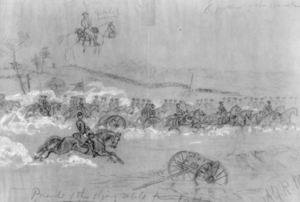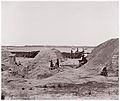Siege of Yorktown (1862) facts for kids
Quick facts for kids Siege of Yorktown (1862) |
|||||||
|---|---|---|---|---|---|---|---|
| Part of the American Civil War | |||||||
 Pursuit of the flying rebels from Yorktown Sunday morning. Alfred R. Waud, artist. |
|||||||
|
|||||||
| Belligerents | |||||||
| Commanders and leaders | |||||||
| George B. McClellan | John B. Magruder Joseph E. Johnston |
||||||
| Strength | |||||||
| 121,500 | 35,000 | ||||||
| Casualties and losses | |||||||
| 182 | 300 | ||||||
The Battle of Yorktown (also called the Siege of Yorktown) happened from April 5 to May 4, 1862. It was a key part of the Peninsula Campaign during the American Civil War.
Union Army Major general George B. McClellan led his troops from Fort Monroe. They were marching towards Richmond, the capital of the Confederacy. Along the way, they met a smaller Confederate force. This force was led by Maj. Gen. John B. Magruder near Yorktown. Instead of fighting a quick battle, McClellan decided to start a siege. A siege means surrounding a place and trying to capture it over time.
Contents
The Start of the Siege
On April 5, 1862, the Union's IV Corps, led by Brigadier general Erasmus D. Keyes, first met the Confederate defenses. This happened at a place called Lee's Mill. McClellan had thought his army would pass through this area easily.
However, General Magruder moved his soldiers around a lot. This made the Union army believe that the Confederate defenses were very strong. The two armies then started an artillery duel. This means they fired cannons at each other. Union scouts also checked out the Confederate forts. They told General Keyes that the forts were indeed very strong. Because of this, Keyes told McClellan not to attack them directly.
Building Up for Battle
McClellan listened to his generals. He ordered his troops to build special siege fortifications. These are strong walls and trenches used to protect soldiers during a long attack. He also brought up his large siege guns. These were very powerful cannons used to break down enemy defenses.
While the Union army was getting ready, General Joseph E. Johnston arrived. He brought more soldiers to help General Magruder and the Confederate forces. These extra soldiers were called reinforcements.
Probing the Defenses
On April 16, Union soldiers tried to find a weak spot in the Confederate line. They attacked a place called Dam No. 1. The Union troops had some early success in this attack. But they did not use this chance to push forward. This mistake caused McClellan to be held up for two more weeks.
During this time, McClellan tried to convince the U.S. Navy to help. He wanted the Navy to sail past the big Confederate cannons at Yorktown and Gloucester Point. His plan was for them to go up the York River to West Point. This would allow them to get behind the Confederate defenses, a move called "outflanking."
The Confederate Escape
McClellan planned a huge bombardment for the early morning of May 5. A bombardment is when many cannons fire at the same time. But the Confederate army had a different plan. They quietly left Yorktown during the night of May 3. They moved towards Williamsburg. This meant McClellan's big attack never happened.
This battle took place near the same spot as the 1781 Siege of Yorktown. That earlier siege was the final major battle of the American Revolutionary War in the eastern United States.
Images for kids
-
In Front of Yorktown, 1862–1863, by Winslow Homer
-
Union battery with 13-inch (330 mm) seacoast mortars, Model 1861, during siege of Yorktown, Virginia 1862.
See also
 In Spanish: Batalla de Yorktown (1862) para niños
In Spanish: Batalla de Yorktown (1862) para niños



































